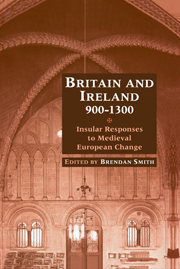Book contents
- Frontmatter
- Contents
- Contributors
- Preface
- List of abbreviations
- 1 The effect of Scandinavian raiders on the English and Irish churches: a preliminary reassessment
- 2 The changing economy of the Irish Sea province
- 3 Cults of Irish, Scottish and Welsh saints in twelfth-century England
- 4 Sea-divided Gaels? Constructing relationships between Irish and Scots c. 800–1169
- 5 The 1169 invasion as a turning-point in Irish-Welsh relations
- 6 Killing and mutilating political enemies in the British Isles from the late twelfth to the early fourteenth century: a comparative study
- 7 Anglo-French acculturation and the Irish element in Scottish identity
- 8 John de Courcy, the first Ulster plantation and Irish church men
- 9 Coming in from the margins: the descendants of Somerled and cultural accommodation in the Hebrides, 1164–1317
- 10 Nobility and identity in medieval Britain and Ireland: The de Vescy family, c. 1120–1314
- Bibliography
- Index
9 - Coming in from the margins: the descendants of Somerled and cultural accommodation in the Hebrides, 1164–1317
Published online by Cambridge University Press: 30 July 2009
- Frontmatter
- Contents
- Contributors
- Preface
- List of abbreviations
- 1 The effect of Scandinavian raiders on the English and Irish churches: a preliminary reassessment
- 2 The changing economy of the Irish Sea province
- 3 Cults of Irish, Scottish and Welsh saints in twelfth-century England
- 4 Sea-divided Gaels? Constructing relationships between Irish and Scots c. 800–1169
- 5 The 1169 invasion as a turning-point in Irish-Welsh relations
- 6 Killing and mutilating political enemies in the British Isles from the late twelfth to the early fourteenth century: a comparative study
- 7 Anglo-French acculturation and the Irish element in Scottish identity
- 8 John de Courcy, the first Ulster plantation and Irish church men
- 9 Coming in from the margins: the descendants of Somerled and cultural accommodation in the Hebrides, 1164–1317
- 10 Nobility and identity in medieval Britain and Ireland: The de Vescy family, c. 1120–1314
- Bibliography
- Index
Summary
One result of the current trend towards ‘British’ history has been an increasing interest in the geographically peripheral or outer zones of medieval Britain, including Border societies, the Isle of Man, the Irish Sea world and the Scottish highlands and islands. In both a British and a more narrowly Scottish context, the integration of the margins of the Scottish kingdom – Argyll and the Isles, Galloway and Moray – forms a major theme for the twelfth and thirteenth centuries. Not surprisingly, many of the milestones in this process are violent ones: the ‘slaughter of the Men of Moray’ at Stracathro in 1130; the uprisings in Galloway following the decision of the Scottish king to dismember that province on the death of its lord, Alan, in 1234; or the fighting at Largs in 1263, which paved the way for the political settlement at Perth in 1266. It has been noted, perhaps facetiously but with a certain amount of truth, that terminology such as the ‘Winning of the West’, ‘connotes images of palefaces and natives, not to mention a shootout at Largs’. Yet as enduring as the theme of conquest has proven – and not just in Scottish history, of course – historians are increasingly devoting their attention to other, more subtle processes which also shaped interactions between societies and the domination of one society by another.
- Type
- Chapter
- Information
- Britain and Ireland, 900–1300Insular Responses to Medieval European Change, pp. 179 - 198Publisher: Cambridge University PressPrint publication year: 1999

